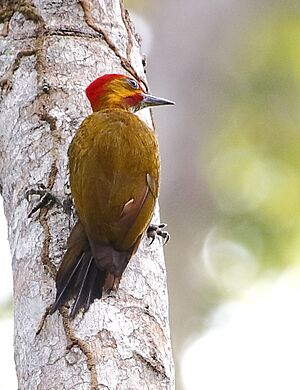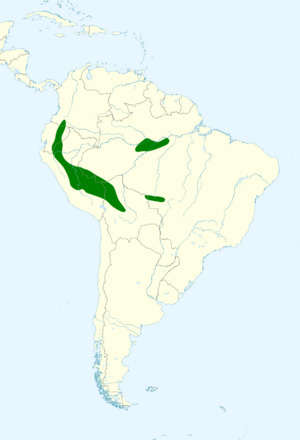White-throated woodpecker facts for kids
Quick facts for kids White-throated woodpecker |
|
|---|---|
 |
|
| A male white-throated woodpecker in Carajás National Forest, Pará, Brazil | |
| Conservation status | |
| Scientific classification | |
| Genus: |
Piculus
|
| Species: |
leucolaemus
|
 |
|
The white-throated woodpecker (Piculus leucolaemus) is a fascinating bird from the woodpecker family, Picidae. You can find this colorful bird in several countries in South America. These include Bolivia, Brazil, Colombia, Ecuador, and Peru.
Contents
About the White-Throated Woodpecker
How Scientists Name Birds
Scientists give every animal a special name. This helps everyone know exactly which animal they are talking about. The white-throated woodpecker was first called Picus leucolaemus. Now, it's part of a group of woodpeckers called Piculus. It is the only type of white-throated woodpecker.
What Does This Woodpecker Look Like?
The white-throated woodpecker is about 19 to 20 centimeters (7.5 to 7.9 inches) long. It weighs around 69 grams (2.4 ounces). That's about as much as a small apple!
Both male and female woodpeckers look very similar. They both have a white chin and throat, which is how they got their name. Their backs are a shiny bronze-green color. Their tail feathers are dark, with green edges.
- Males: Have bright red feathers on their forehead and the back of their neck. They also have a wide red stripe on their cheeks, with a yellow stripe just above it.
- Females: Only have red feathers on the back of their neck. The rest of their head looks like the male's, but without the red on the forehead or cheeks.
Their chest is yellowish-green, and the rest of their belly is white with olive stripes. They have a dark beak and dark brown or reddish-brown eyes. Young woodpeckers are usually greener than the adults.
Where Do White-Throated Woodpeckers Live?
Woodpecker Homes and Habitats
You can find the white-throated woodpecker in western Colombia. They also live along the eastern side of the Andes mountains in Ecuador and Peru. Their home range extends south into central Bolivia. There are also groups of them living in the Amazon rainforest in western and central Brazil.
These woodpeckers love to live in old, moist forests. They prefer forests that are on firm ground, called terra firme forests. They also live in várzea forests, which are forests that sometimes flood. They live in lowlands and foothills. In Ecuador, they can be found up to 1,000 meters (3,300 feet) high. In Peru, they can live up to 1,400 meters (4,600 feet) high.
How White-Throated Woodpeckers Behave
Staying in One Place
The white-throated woodpecker is a resident bird. This means it stays in the same area all year long. It does not migrate to different places.
What Do Woodpeckers Eat?
This woodpecker usually looks for food by itself. Sometimes, you might see them in pairs. They also join groups of different bird species that are feeding together. They search for food in the middle and upper parts of the forest trees.
They find their food by poking into bark or peeling it off. While scientists don't know exactly what they eat, they believe it includes adult insects and their larvae (baby insects).
Woodpecker Reproduction and Life Cycle
Right now, scientists do not know much about how white-throated woodpeckers reproduce. We don't have details about their nests, eggs, or how they raise their young.
What Does This Woodpecker Sound Like?
The white-throated woodpecker has a unique call. It sounds like a "hoarse" or "hissing" noise. People describe it as "sraa-sraa-sraa-" or a long, hissing "wheeeeee."
Is the White-Throated Woodpecker Safe?
The IUCN (International Union for Conservation of Nature) checks on animals around the world. They have listed the white-throated woodpecker as a species of "Least Concern." This means it is not currently in danger of disappearing.
Even though it has a large area where it lives, its total population size is not known. Scientists believe the number of these woodpeckers might be going down. However, no immediate threats have been found. It is a bird that isn't seen very often. It has been hard to study because scientists were not always sure about its exact species.


